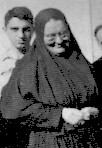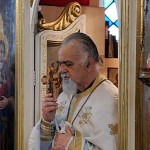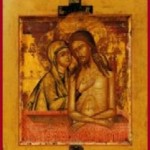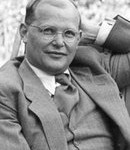[/caption]
and being the servant of one’s neighbor in the world. Through his life and writings, we can see a Christian who does not cloister his faith, but makes faith alive in service to humanity. For Bukharev, a faith alive was one that had a social context to alleviate suffering in the earthly world. As Behr-Sigel says: “Bukharev’s approach was the integral connection between this ‘mystical theology’ and the concern for a compassionate, actively creative and transforming presence in the world.” The Monk in the City as Elisabeth titles her essay elucidates a life of service linked with a profound spiritual empting of one’s self to express the love of Christ. This theology expresses “worship of the living God through service to others” is evocative of the life of Mother Teresa of Calcutta.
The proceeding chapter focuses on the story of Mother Maria Skobtsova (1891-1945)a spiritual inheritor of the theology of Bukharev. Born in Latvia, her name in the world was Elisabeth Pilenko. She became a politically active Socialist in Russia around the time of the revolution; escaping to Paris with her husband. In Paris, she became involved with the Russian Students Movement and became friends with many of the Russian theological intelligentsia. Sergius Bulgakov became her father confessor. A theologian, poet and social worker she petitioned her bishop to take up the habit. She was professed and was given the monastic name Maria.
[caption id="attachment_332" align="alignright" width="102" caption="Mother Maria of Paris"] [/caption]
She strongly wished to continue a monasticism open to the world in the manner of Alexander Bukharev. In the 1930s she reached out to the suffering poor of Paris. A controversial socially active monasticism caused a scandal with more conservative church members, but Mother Maria endured. With the advent of World War II, Mother Maria and her friends reached out to help Jews hide and escape Nazi persecution. She was betrayed to the Germans and was put to death, taking the place of a young girl scheduled to die in the gas chambers. Her martyrdom took place in the last days of the war in Ravensbruck concentration camp; On January 18, 2004, the Holy Synod of the Ecumenical Patriarchate in Istanbul recognized Mother Maria Skobtsova as a saint along with her son Yuri, the priest who worked closely with her, Fr. Dimitri Klépinin, and her close friend and collaborator Ilya Fondaminsky. All four died in German concentration camps. On January 18, 2004, the Holy Synod of the Ecumenical Patriarchate in Istanbul recognized Mother Maria Skobtsova as a saint along with her son Yuri, the priest who worked closely with her, Fr. Dimitri Klépinin, and her close friend and collaborator Ilya Fondaminsky.]]>
[/caption]
She strongly wished to continue a monasticism open to the world in the manner of Alexander Bukharev. In the 1930s she reached out to the suffering poor of Paris. A controversial socially active monasticism caused a scandal with more conservative church members, but Mother Maria endured. With the advent of World War II, Mother Maria and her friends reached out to help Jews hide and escape Nazi persecution. She was betrayed to the Germans and was put to death, taking the place of a young girl scheduled to die in the gas chambers. Her martyrdom took place in the last days of the war in Ravensbruck concentration camp; On January 18, 2004, the Holy Synod of the Ecumenical Patriarchate in Istanbul recognized Mother Maria Skobtsova as a saint along with her son Yuri, the priest who worked closely with her, Fr. Dimitri Klépinin, and her close friend and collaborator Ilya Fondaminsky. All four died in German concentration camps. On January 18, 2004, the Holy Synod of the Ecumenical Patriarchate in Istanbul recognized Mother Maria Skobtsova as a saint along with her son Yuri, the priest who worked closely with her, Fr. Dimitri Klépinin, and her close friend and collaborator Ilya Fondaminsky.]]>
Being in the Desert
[/caption] As a young boy, I remember my dad, who was a priest, always placed the Holy Cross on a tray of bright yellow daffodils. This sign of spring and the promise of the coming of Pascha seemed enough when I was that age. Now, I don’t know! I am much older; life is much more complex. Our consumer society offers so many distractions and alternatives. In every Orthodox parish there is the increased availability of services during this period, but there is also all those other things that sidetrack us. It is so easy to say not tonight, not this morning, next time. So what should we do? I know you’re probably thinking … Here it comes – the scolding and the guilt trip. Actually no – because this year I am more at fault than most of you! Well, again, what do we do? I really don’t know. Last night, when I was trying to think how to structure this entry something came to me. Maybe, what I need is to quiet the clamor. The word that came to mind, which reminded me of St. Gregory Palamas, is hesychia, silence or quiet. This might be the time to sit down, shut the world out and let God speak to me and tell me how to fight the slump. What a novel idea listen, don’t think – don’t talk – just listen. As you probably guessed, the concept of not thinking and being quiet is difficult for me. I’ll let you know if it helps.]]>
Discerning the Signs of the Times (Part 2)
Orthodoxy and Peace. Rightly, the beginning of this chapter deals with the liturgical aspect of peace. Even though it is not always emphasized, this should be the crux of any discussion of the theology of the Church. I once read a statement from a well known Orthodox theologian who endured the Communist repression of the Church in the last century. He said that Church was striped of all her riches, schools, and influence; as long as the Liturgy was served, the Church would survive. This was the reality of persecuted Orthodoxy; liturgy is the heart of the Church and fed the soul of the faithful. Behr-Sigel chose to begin her essay with this observation. She points out the central place of peace within the Divine Liturgy. The deacon begins the Great Litany asking that “peace” be the entire bearing of the participants in the liturgy.
[caption id="attachment_313" align="alignleft" width="150" caption="Peace Unto All"] [/caption]
The priest blesses and calls for “peace for the congregants and they respond asking for his spirit to be peaceful. Clergy exchange the Kiss of Peace. With the exception of the personal pronouns “we and us,” peace is the single most often used word in our liturgy. After focusing on the centrality of peace in the liturgy, Elisabeth then discusses the effect that nationalism and national identity influence the Church and its mission to strive for peace among nations. No doubt, complex geopolitical issues affect the closely knit church-state relations in many Orthodox countries. Behr-Sigel points out areas of concern to Orthodox peoples; Serbia (note the date of the article), Palestine, and the cooperation of Constantinople, Russia and the WCC and peace efforts. Never the less, the increased presence of Orthodoxy in the west should help provide a catalyst for a pan-orthodox peace movement. For further information link to the Orthodox Peace Fellowship (http://www.incommunion.org)
Chapter Four discusses a theological theme which is dear to my heart. The topic is the concept of kenosis.(see post Standing by) The scriptural heart of this principle is not only Philippians 2, 5-7 as pointed out in the essay, but also all of salvation history.
[caption id="attachment_319" align="alignright" width="150" caption="Extreme Humility"]
[/caption]
The priest blesses and calls for “peace for the congregants and they respond asking for his spirit to be peaceful. Clergy exchange the Kiss of Peace. With the exception of the personal pronouns “we and us,” peace is the single most often used word in our liturgy. After focusing on the centrality of peace in the liturgy, Elisabeth then discusses the effect that nationalism and national identity influence the Church and its mission to strive for peace among nations. No doubt, complex geopolitical issues affect the closely knit church-state relations in many Orthodox countries. Behr-Sigel points out areas of concern to Orthodox peoples; Serbia (note the date of the article), Palestine, and the cooperation of Constantinople, Russia and the WCC and peace efforts. Never the less, the increased presence of Orthodoxy in the west should help provide a catalyst for a pan-orthodox peace movement. For further information link to the Orthodox Peace Fellowship (http://www.incommunion.org)
Chapter Four discusses a theological theme which is dear to my heart. The topic is the concept of kenosis.(see post Standing by) The scriptural heart of this principle is not only Philippians 2, 5-7 as pointed out in the essay, but also all of salvation history.
[caption id="attachment_319" align="alignright" width="150" caption="Extreme Humility"] [/caption]
The kenosis of Our Lord is at the center of Orthodox theology. God humbling Himself to take on flesh, so that He could identify with us His creation is the essence of His salvific mission in obedience to the will of the Father. The hymns, poetry and art of the Church bear witness to this tenet. Behr-Sigel describes the prevalence of this concept in Russian theological thought and literature. The monastic vocation is a true reflection of this theological concept and has been since its inception in the Egyptian and Palestinian deserts. Modern Greek theologians Zizioulas, Nellas, and Vlachos; in addition to many familiar Russian theologians have written about this aspect of Orthodox theology. Dr. Behr-Sigel masterfully weaves the theme of kenosis and its imprint on the soul of Russia and her people.]]>
[/caption]
The kenosis of Our Lord is at the center of Orthodox theology. God humbling Himself to take on flesh, so that He could identify with us His creation is the essence of His salvific mission in obedience to the will of the Father. The hymns, poetry and art of the Church bear witness to this tenet. Behr-Sigel describes the prevalence of this concept in Russian theological thought and literature. The monastic vocation is a true reflection of this theological concept and has been since its inception in the Egyptian and Palestinian deserts. Modern Greek theologians Zizioulas, Nellas, and Vlachos; in addition to many familiar Russian theologians have written about this aspect of Orthodox theology. Dr. Behr-Sigel masterfully weaves the theme of kenosis and its imprint on the soul of Russia and her people.]]>
Standing By…
stavrotheotokion. If we look at this compound word and break it down to its component parts we can recognize a couple of fairly familiar Greek words, Stavro – Greek for cross and Theoto(kos), the Mother of God. Now, we can connect the concepts The Theotokos and the Cross. The Stavrotheotokion is a troparion (short hymn with a theme usually sung after a verse of psalm), which is a manifestation of true human emotion. It is a poetic expression of the pain, sorrow and astonishment of a mother beholding her Son and her God on the Cross. These verses of theology and tenderness are heard in many of the services of the Great Lent, but reach their zenith in the services of the Holy Passion. The Theotokos expresses the wonder of us all. The awe, which could only be articulated by a mother who has kept a secret for many years (“and his mother kept all these things in her heart” Luke 2, 51). The identity of her Son as the incarnate God was known the Theotokos since the Annunciation. Now she suffers a new mystery, the inscrutability of her Son and Creator taking on death by His own free choice. Each of these verses proclaims the truth of Christ’s condescension.
[caption id="attachment_299" align="alignleft" width="150" caption="The Lament of the Virgin"] [/caption]
[/caption]
…”Woe is me beloved Child, light of my eyes! Thou has hung the earth above the waters, how can you endure to be nailed upon the Tree between two evildoers.” – Vespers of Tuesday in the Third Week.
None the less, the Virgin stands by the cross, hour by hour true to her mission to intercede for the entire world. Her pain is palpable. Her lament is moving and yet there is true nobility in her devotion. When all the disciples, except John the Beloved, had fled because of their fear, she and the other women stood there unafraid. St. Romanos the Melodist has captured her grief and her consolation in a kontakion (a combination of troparia of the same structure, connect alphabetically or acrostically) used on Great and Holy Friday. This dialogue between the Theotokos and her Son becomes the revelation of God’s plan of salvation in poetry. This kontakion is lyrical theology, stavrotheotokion with the voice of response by our Crucified Lord. Christ assures the Theotokos just as she witnesses his hanging on the Cross, she would receive this grace. [caption id="attachment_302" align="alignright" width="91" caption="The Theotokos at the Cross"] [/caption]
“Courage, Mother because you will see me first on my coming first from the tombs. I am coming to show you by how many toils I ransomed Adam and how much I sweated for his sake. I shall show it to my friends by showing the marks in my hands and then you will see Eve, Mother, living as before, and you will cry out with joy: ‘He has saved my forebears, my Son and my God.’*
*(St. Romanos the Melodist. On the Life of Christ: Kontakia. Translated by Archimandrite Ephrem Lash. Edited by Kerry Brown, The Sacred Literature Series. New York et al.: HarperCollins Publishers, 1995, p. 148).]]>
[/caption]
“Courage, Mother because you will see me first on my coming first from the tombs. I am coming to show you by how many toils I ransomed Adam and how much I sweated for his sake. I shall show it to my friends by showing the marks in my hands and then you will see Eve, Mother, living as before, and you will cry out with joy: ‘He has saved my forebears, my Son and my God.’*
*(St. Romanos the Melodist. On the Life of Christ: Kontakia. Translated by Archimandrite Ephrem Lash. Edited by Kerry Brown, The Sacred Literature Series. New York et al.: HarperCollins Publishers, 1995, p. 148).]]>
Discerning the Signs of the Times ( Part 1)
Continuing this introduction to Mme. Behr-Sigel in chapter one she relates her journey to embrace the faith. I was struck how very similar her story was to so many of our fellow Orthodox in this country. Marriage to a member of the Church combined with study and the influence of church members all contributed to bring Dr. Behr-Sigel to Orthodoxy. As a noted member of the academy in France, Mme. Behr-Sigel brought a wealth experiences to the Church family. Additionally, she lived during the critical times of the two world wars and the turmoil within the Christian communities of Europe and the world as the result of the wars. The two great issues which incited fervor in Dr. Behr-Sigel were questions that, in my opinion, remain to be fully explored and more completely resolved. These concerns are the subject of the full participation of the royal priesthood, most especially women, in the Church and the question of how the Church responds to the challenges of modernity and its impact on the Church. These two great trials continue to confront us as the Church. It will be a voyage of discovery as we read this book. I read with great personal interest the second chapter of the book. These pages contain a reprint of an address Behr-Sigel gave at the Orthodox Theological Institute at Cambridge in 1998. The topic of Dr. Elizabeth’s lecture discussed the task of Orthodox Theological Formation. This talk was an opportunity to once again return to the two themes which animated Behr-Sigel, the role of women in the Church and modernity and the Church. If one reads the speech closely the call for Orthodox theological formation at a center of western learning was essential to equip future Church leaders to address issues facing us in this age. The Institute for Orthodox Christian Studies at Cambridge (http://www.iocs.cam.ac.uk/) has provided a fertile environment for teaching theology to the lay, academic, and pan-Orthodox peoples of Great Britain for over ten years. Ria and I have been privileged to benefit from many of the Institutes programs during our years in Britain. The vision of Dr. Behr-Sigel, expressed in her address, that the centre at Cambridge becomes a source of teaching Orthodox Tradition has been realized. Dn. George]]>
Adams Longing
[/caption]
Most strikingly this image is brought to our attention during the first and fifth week of the Great Fast with the Great Canon of St. Andrew of Crete. This beautiful piece of poetry is more than words and chant. The difficulty that we experience is that the theology and metaphors are lovely, but how do we relate to them in this day and age. The theme of repentance has been developed from the pre-lenten Sundays until this time in Lent, so let’s leave that one aside. I would like to think about an aspect of the illustration of Adam sitting in front of the gates pondering his circumstance. The idea that we must sit back and consider “where we are” is one painfully close to home. When I think about the things that must have been going through Adam’s mind, one possibility keeps bothering me more than any other. It occurs to me that he might very well be thinking about being separated from a friend, a real friend, one who genuinely cared for him. Was Adam aware of his new condition? How aware was he of the emptiness in his heart and did he long to have God back in his life?
During these difficult days, people out of work (me included), the economy in a tailspin, major companies in trouble and the markets very unpredictable, the sense of uncertainty can be overwhelming. What must Adam have been thinking? Talk about an uncertain future! Did he ask the same questions we all have asked? Where do I go from here? My world has changed, it will never again be the same, – can I cope? Where has God gone? The reality is that even after Adam had disobeyed God’s law; God came looking for him. The plan of salvation was already in process. God loved so much He already had humanity’s restoration willed through the grace of the mystery of the incarnation of the Son through the Holy Spirit, for our sake. As Christians, we live in the light of Christ’s Resurrection. Our fallen nature has been lifted out of Hades, just as our ancestral parents were seized by the hand of Christ and rescued from darkness. When we think that our life is so dark know that Christ our God is there in the darkness waiting to lift us up by the hand.
[caption id="attachment_286" align="aligncenter" width="86" caption="The True Helping Hand"] [/caption]
Our prayer should be: “O my God, here is my hand!”]]>
[/caption]
Our prayer should be: “O my God, here is my hand!”]]>
New Friday Feature
Discerning the Signs of the Times. (Plekon, Michael and Sarah E. Hinliky, eds. Discerning the Signs of the Times: The Vision of Elisabeth Behr-Sigel, Trans. by Lyn Breck, Michael Plekon, Deno Takles, and Rachel Mortimer, Crestwood NY: St. Vladimir’s Seminary Press, 2001.). This will be the focus of this blog each Friday. I will share with you my thoughts as I re-read this outstanding book.
[caption id="attachment_280" align="alignleft" width="109" caption="Dr. Elisabeth Behr-Sigel"] [/caption]
So that we start even, this entry will be a bit of an introduction to the remarkable Dr. Elisabeth Behr-Sigel. This woman was born in Strasbourg FR. in 1907. Born into a French Protestant family she was introduced to Orthodoxy by the Russian émigré community in Paris. In her 98 years she became a prophetic voice in twentieth century Orthodoxy. In one of her great works The Ministry of Women in the Church (Behr-Sigel, Elizabeth., The Ministry of Women in the Church. translated by Stephen Bigham, English ed. Redondo Beach CA: Oakwood Publications, 1991.) she wrote: “The Church is a community equal although different persons within the radiant mystery of the Trinity. All members, both men and women, are turned toward Christ who saves and reconciles all human beings.” True to herself and Christ, Behr-Sigel was not afraid to ask uncomfortable questions and to seek answers that might give us all a better vision of the Holy Spirit alive in the Church. This is why, as I read this book during Great Lent, I would like to share some of my impressions and feelings with you. In these next few weeks, we will gain a sense of the vision of Mme Behr-Sigel, hopefully, as she did we will pose the right questions and stimulate our thinking to consider the possibilities; most importantly please share your thoughts and comments with us all. To learn more about Elisabeth Behr-Sigel, Google her name and read about this “Grandmother of Western Orthodoxy”, better still if you have a chance read one of her books. Thank You Dn. George]]>
[/caption]
So that we start even, this entry will be a bit of an introduction to the remarkable Dr. Elisabeth Behr-Sigel. This woman was born in Strasbourg FR. in 1907. Born into a French Protestant family she was introduced to Orthodoxy by the Russian émigré community in Paris. In her 98 years she became a prophetic voice in twentieth century Orthodoxy. In one of her great works The Ministry of Women in the Church (Behr-Sigel, Elizabeth., The Ministry of Women in the Church. translated by Stephen Bigham, English ed. Redondo Beach CA: Oakwood Publications, 1991.) she wrote: “The Church is a community equal although different persons within the radiant mystery of the Trinity. All members, both men and women, are turned toward Christ who saves and reconciles all human beings.” True to herself and Christ, Behr-Sigel was not afraid to ask uncomfortable questions and to seek answers that might give us all a better vision of the Holy Spirit alive in the Church. This is why, as I read this book during Great Lent, I would like to share some of my impressions and feelings with you. In these next few weeks, we will gain a sense of the vision of Mme Behr-Sigel, hopefully, as she did we will pose the right questions and stimulate our thinking to consider the possibilities; most importantly please share your thoughts and comments with us all. To learn more about Elisabeth Behr-Sigel, Google her name and read about this “Grandmother of Western Orthodoxy”, better still if you have a chance read one of her books. Thank You Dn. George]]>
The Beginning of Great Lent 2009
AS OUR HOLY ORTHODOX CHURCH PREPARES US GREAT LENT, SHE PREPARES US FOR A JOURNEY. SHE SPEAKS TO US CONCERNING OUR JOURNEY TO PASCHA. THE JOURNEY WE BEGIN IS TO THE CROSS, TO THE TOMB AND TO THE GLORIOUS RESURRECTION OF OUR LORD, GOD AND SAVIOUR, JESUS CHRIST. WE ARE REMINDED THAT WE WILL NOT MAKE THIS JOURNEY ALONE, BUT THAT WE WILL JOURNEY WITH THE LORD, AND TRAVEL WITH OUR BROTHERS AND SISTERS IN CHRIST. PREPARING FOR THIS JOURNEY WE ARE NOT GIVEN A LIST OF THINGS TO BRING, NOR DOES THE CHURCH TELL US WHAT TO EAT OR NOT TO EAT ON THE ROAD. HOWEVER, SHE SPEAKS DIRECTLY TO US ABOUT OUR ATTITUDES. LENT CAN BE SUMMED UP BY THE PHRASE, “SHARING AND CARING” INSTEAD OF “DO’S OR DON’TS”. ATTITUDES CONCERNING OUR NEIGHBOUR ARE OF THE PRIMARY IMPORTANCE DURING THIS PREPARATION FOR PASCHA. IN OUR HEARTS, EACH OF US KNOWS THAT OUR LIVES ARE FAR FROM PERFECT. WE REALIZE THAT WE MUST SEEK FORGIVENESS FROM GOD FOR FALLING AWAY FROM HIM, BY PUTTING HIM OUT OF FOCUS IN OUR LIVES. WE KNOW THAT THIS FORGIVENESS IS NECESSARY FOR OUR RETURN TO HIM. AT THE BEGINNING OF THE GREAT FAST, WE ARE TOLD THAT THE FORGIVENESS, WHICH WE SEEK FROM GOD IS CONDITIONAL. IT IS CONTINGENT ON OUR ATTITUDES TOWARD OTHERS. ARE WE PREPARED TO SHARE OURSELVES WITH OUR NEIGHBOUR? ARE WE PREPARED TO CARE WITH COMPASSION? CAN WE FORGIVE OTHERS? DO WE CARRY ANIMOSITY IN OUR HEARTS, WHILE SEEKING FORGIVENESS FOR OURSELVES? OUR FORGIVENESS FROM GOD IS COMMENSURATE WITH THE FORGIVENESS WE OFFER THOSE WHO HAVE OFFENDED US. THE GREAT CHRISTIAN MARTYR OF THIS LAST CENTURY, DIETRICH BONHOEFFER SUMMED UP OUR RESPONSIBILITY TO OUR FELLOW CHRISTIANS IN THIS WAY:

- Dietrich Bonhoeffer
“REJOICING IN THE VIRTUES OF THE SPIRIT – MAY WE PERSEVERE WITH LOVE, AND SO BE COUNTED WORTHY TO SEE THE SOLEMN PASSION OF CHRIST OUR GOD, AND WITH GREAT SPIRITUAL GLADNESS TO BEHOLD HIS HOLY RESURRECTION.”
]]>